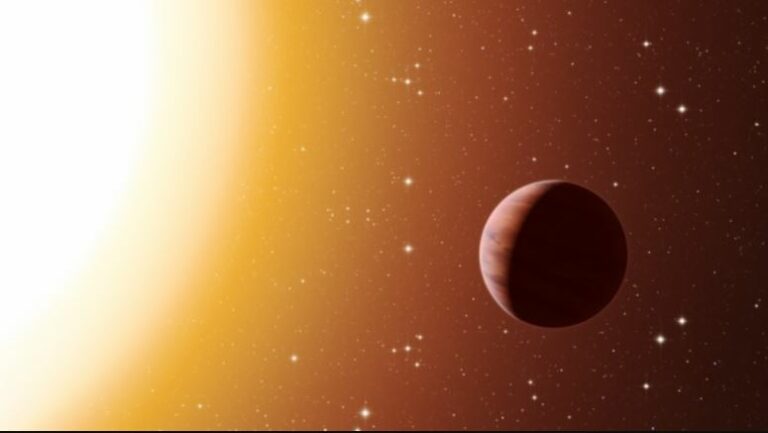New Research Reveals Proximity of Hot Jupiters to Their Host Stars
“Insights into the Formation of Hot Jupiters Challenge Previous Assumptions”
Gas giant exoplanets similar to Jupiter but located in close proximity to their host stars are commonly referred to as “hot Jupiters.” The prevailing understanding of their formation is being questioned as recent developments shed new light on the subject. Traditional theories suggested that hot Jupiters are formed under circumstances that prevent the existence of other smaller planets within the same system.

According to astronomers, hot Jupiter systems are believed to be the result of massive planets being gravitationally pulled closer to their stars, thereby displacing smaller planets as if they were intimidated by a schoolyard bully. This explanation aligns with observational data, which indicates that many of these systems lack smaller planets in the vicinity of the giants.
However, recent data challenges this conventional wisdom. Songhu Wang, an assistant professor of astronomy at Indiana University, states, “Our research indicates that at least some hot Jupiters cannot be formed through such a violent process.” Wang, along with Dong-Hong Wu of Anhui University and Malena Rice of the Massachusetts Institute of Technology, presented their research at the 2023 summer meeting of the American Astronomical Society. Wang adds, “This significant contribution enhances our understanding of hot Jupiter formation and provides insights into our own solar system.”
Wang and his colleagues employ this data to develop models that shed light on the formation of our solar system, as well as other types of planetary systems, while also determining the prevalence of different planetary system types. Astronomers have long been intrigued by the absence of hot Jupiters in our own solar system, despite their apparent frequency elsewhere.
This latest research provides additional evidence in line with previous studies indicating that hot Jupiters may form in situ, meaning they originate near their host stars rather than forming at a distance and subsequently migrating inward. Astronomers Elizabeth Bailey and Konstantin Batygin previously proposed an alternative formation mechanism for hot Jupiters that aligns with the recent data.
Dr. Wang, expressing the astronomers’ ultimate goal of understanding our solar system within a larger context, stated, “Are we unique?” Investigating the formation of hot Jupiters and their role in the development of planetary systems remains a focal point for astronomers. Notably, models suggest that Jupiter’s presence and its specific location within our solar system may have played a vital role in the emergence and sustainability of life on Earth.
Planetary scientists propose that Jupiter may have played a crucial part in fostering life on our planet. As Alan Boss from the Carnegie Institution of Washington summarizes, “A long-period Jupiter may be a prerequisite for advanced life.” Why? Jupiter acted as a shield, protecting early life on Earth from frequent asteroid and comet impacts. If it were not for Jupiter, positioned at just the right distance from the Sun to allow for the existence of smaller planets, Earth could have experienced frequent catastrophic events like the asteroid impact that led to the extinction of dinosaurs.
Understanding the formation of Jupiter-like worlds in exoplanetary systems is crucial due to their potential significance in the development of life. This knowledge enables astronomers to estimate the prevalence of life in the cosmos. Recent data, for instance, suggests that red dwarf stars generally lack Jupiter-like planets in their orbits, which is of great interest to the astronomical community.

Red dwarfs, which constitute a significant portion of the Milky Way’s stellar population, are smaller and cooler than the Sun. Due to their prevalence, red dwarfs with planetary systems are often the subject of studies aimed at identifying potentially habitable worlds beyond our own solar system. However, if these stars rarely, or perhaps never, host Jupiter-like planets, which are believed to be vital for the development of life, what does this mean for our quest to find life elsewhere in the universe?
Recent findings from another study suggest that dwarf stars generally lack giant Jupiter-like planets. Emily Pass from the Harvard/Smithsonian’s Center for Astrophysics reports that red dwarf stars do not appear to possess planets that fulfill the same role as Jupiter does in our solar system. This finding holds significance because many red dwarfs are among our closest stellar neighbors. Approximately five out of every six nearby stars belong to the red dwarf class, making them a primary target in the search for extraterrestrial life.
While the absence of Jupiter analogs in red dwarf systems may imply that these planetary systems are less conducive to supporting life, Pass encourages maintaining an optimistic outlook, emphasizing the vast amount we still have to learn. “Although this discovery suggests a scarcity of truly Earth-like planets around red dwarfs, there is still much about these systems that remains unknown, so we should remain open-minded.”
Do not forget to share your opinion with us to provide you with the best posts !




0 Comments